 |
こんにちは。セインさん。今日は神田の「いせ源」に来ましたよ。
天保元年(1830)年創業で、最初はどじょう屋さんから始まったそうですが、いろいろな料理を出すなかで「あんこう鍋」に人気が集中したため、大正時代からは「あんこう鍋」専門店となって、今に続いているそうです。
Hi Thayne-san, today we’re going to visit Isegen, in Kanda.
It started as a seafood restaurant in 1830, but of all their dishes, the monkfish hotpot was the most popular, and so in the Taisho Period they became, and remain today, a monkfish hotpot restaurant. |
|
|
 |
東都のれん会のお店は、どこも歴史がありますが、ここは建物も昔の建物のままなんですね!すごい!
I know all the Toto Norenkai businesses have a lot of history behind them, but the Isegen building is also really old. It’s really nice! |
|
|
 |
建物は80年以上たっているそうです。東京都の歴史的建造物にも選定されているんですよ。さあ、入りましょう。こんにちは。
The building is over 80 years old. It’s designated as a historical building of Tokyo. Well, shall we go in? |
|
|
|
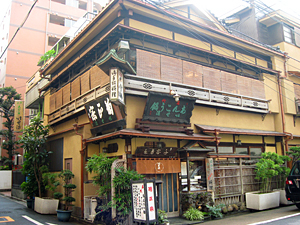 |
|
|
| (立川) |
こんにちは! セインさん、コンシェルジュさん。立川博之です。
Hi! Thayne-san, and Concierge-san, it’s great to meet you. I’m Tachikawa Hiroyuki. |
|
|
 |
初めまして、セインです。若いご主人で、びっくりしました。何歳ですか?
It’s a pleasure. I’m Thayne. You’re quite young for a restaurant owner. May I ask how old you are? |
|
|
| (立川) |
30歳です。大学を出たあと、約2年間、銀行マンとして働いていたんですが、父が体調を崩したこともあって家に戻ったんです。
I’m 30. After finishing university I worked for a couple years at a bank, but then my father fell ill, and I came back home. |
|
|
 |
サラリーマンをしていた人が、若くして家に戻って、老舗の後継ぎになる時って、どういう気持ちなんですか?
What was it like returning home at a young age to take over the restaurant, after working at a company? |
|
|
| (立川) |
僕は、子どもの頃からあんこう鍋を食べて、おいしさを知っていましたし、祖父や父の姿をいつも見ていたので、いつかは後を継いでやってみたいな、と思っていました。ですから、帰るのが嫌だということはなかったんです。ただ、ものすごく忙しい職場にいたので、正直、家に戻るとちょっと退屈なんじゃないかな、とは思っていました。 でも、実際に仕事を始めると、毎日いろんなことがあるんです。日々、素材も違えば、お客様も違いますから。それに、メニューの開発や、あんこうの保護のことなど、この特徴ある店から社会に向けて発信できることもいろいろあるだろうと思っていて……。
Ever since I was a child I had had monkfish hotpot and knew how tasty it was, and I had watched my father and grandfather working in the restaurant, so I actually thought it would be fun to take over the shop. I didn’t have any problem at all about returning home. At first, I did think it would be a little boring, frankly, because I had been working in a really busy environment. But once I actually started working, I realized that every day is different. The ingredients we buy change, and we get new customers. I’m also always working on our menu, helping with monkfish conservation, and thinking about what kinds of things our unique shop can share with the world. |
|
|
 |
あんこうという資源を守るところから、店を考えていこうというわけですね。
So you manage your business starting from how to protect the monkfish? |
|
|
| (立川) |
はい。
ところでセインさんは、あんこうという魚はご存じですか?
That’s right.
By the way, are you very familiar with the monkfish, Thayne-san? |
|
|
 |
いえ、見るのも食べるのも今日が初めてです。
Yes, it’ll be my first time to both see and eat one. |
|
|
| (立川) |
ちょうど今から吊るし切りをするところなんですが、ご覧になりますか?
Well, I’m just about ready to clean a monkfish. Would you like to see it done? |
|
|
 |
もちろん!
Certainly! |
|
|
|
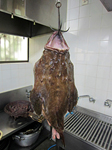 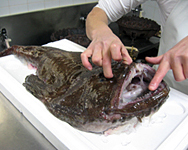 |
|
|
 |
うわぁ、立派な魚ですね。それに……とてもユニークな顔ですね。
Wow, that’s quite a fish. It’s got a very…uh…unique face. |
|
|
| (立川) |
はい、とても愛嬌があります(笑)。これは8.8kgほどですから中程度。20kgくらいの大きなものまで扱います。口を開けると、歯が2段階に生えているでしょう。これで魚でも貝でも食べるんですよ。
では、始めます。まず、表面のぬめりを包丁の背で取ってから、頭を上にして、かぎで吊るします。そして……肝(きも)を取り出します。
Yes, it’s quite charming, haha. This one is about 8.8 kg, which is about mid-size. We get some up to about 20 kg. If you look in their mouth, you can see two rows of teeth. They use those to eat both fish and shellfish.
Let’s start. First, we wipe the slime off with the back of the knife and hang the fish on the hook with its head facing up. Then we take out the liver. |
|
|
 |
大きい!
That’s huge! |
|
|
| (立川) |
測ってみましょうか……。1.1kgですから、体重のちょうど8分の1が肝臓ということですね。肝臓が大きいあんこうは、身もおいしいんですよ。
Shall we weigh it? . . . it comes to 1.1 kilograms, which means exactly an eighth of its total body weight is the liver. Monkfish with large livers are particularly delicious. |
|
|
 |
この肝を蒸した「きも刺し(あん肝)」は、お酒のお伴にぴったりなんです。
Steamed monkfish liver, which is called kimo-sashi (kimo means liver), is the perfect accompaniment to sake. |
|
|
| (立川) |
続いて切り出すのが……胃。次に……透明感のあるのが卵巣。さらに……大きなひれ。……皮はコラーゲンのかたまりですから、女性の方に人気があります。……そして頬。……大身。これで終わりです。
The next organ we cut out is the stomach. Then, the ovaries, followed by the large fin. The skin is full of collagen, and so it’s especially popular with women. Finally, the cheeks, . . . and body. That’s everything. |
|
|
|
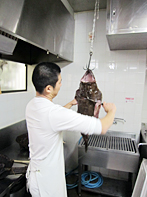 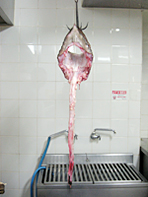
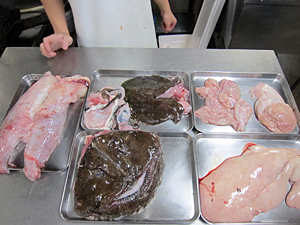
|
|
あんこうの7つ道具。右下から反時計まわりに、
肝臓、胃、卵巣、ひれ、皮、大身、頬
The seven dogu (tools) of the monkfish. Counter-clockwise from bottom
right: liver, stomach, ovary, fin, skin, body, cheeks. |
|
|
  |
わー、ほぼ全部、なくなりましたね。これを全部鍋に入れるんですか?
Wow, almost everything is gone now. Does all of this go into the hotpot? |
|
|
| (立川) |
はい。あんこうは、ほとんど捨てるところがない魚で、鍋には今、取った肝、胃、卵巣、ひれ、皮、頬、大身をすべて入れます。これを「あんこうの7つ道具」と呼んでいるんです。
That’s right. Very little is wasted with monkfish. Everything we cut out just now goes in. These are called the “seven dogu of monkfish.” |
|
|
 |
「あんこうの七つ道具」?!
The seven dogu of monkfish!? |
|
|
 |
内臓や皮を食べる魚は他にもありますが、こんな言い方をするのは、あんこうだけです。不思議ですね。
じゃあ、セインさん。いよいよ「あんこう鍋」をいただきましょう。
With other fish, we eat the organs or skin, but only with monkfish do we use such a term Kind of strange, isn’t it?
Well, Thayne-san, are you ready to enjoy your first bowl of monkfish hotpot? |
|
|
|
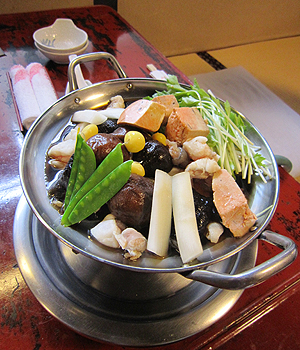 |
|
あんこう鍋。具は、あんこうの7つ道具のほかに、豆腐と季節の野菜。 |
|
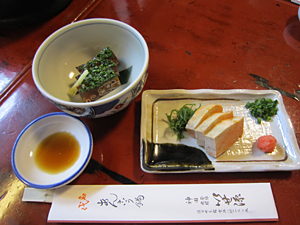 |
|
「きも刺し」と卵巣をだしで煮てかためた「煮こごり」 |
|
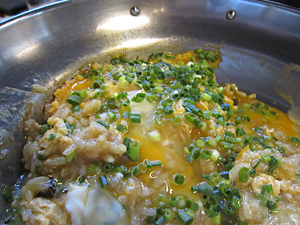 |
|
締めは、「おじや」。おいしかった~! |
|
|
|
*******食後******* |
|
|
 |
あー、おいしかった! 立川さん、このおだしは、どうやって作っているんですか?
Mmm, that was really good! Tachikawa-san, how do you make the broth? |
|
|
| (立川) |
それは企業秘密です(笑)。分量自体は、だし・砂糖・醤油が中心のシンプルなものですが、火加減や合わせるタイミング、寝かせる時間等で味も大きく変わってきます。そして、一緒に煮込むあんこうと鍋具材からの旨味とが調和することで煮汁が完成します。
あんこうは実は、少し臭みがあるんですが、生きのよいものを仕入れて、すばやく丁寧に下処理をすると、本当においしい魚です。市場の人も、産地の人も、うちが素材にこだわっていることを知っていますから、いいあんこうが入ると、「これは、いせ源に」と、取っておいてくれるんです。
That’s a secret! We use simple ingredients―it’s mainly dashi, sugar and soy sauce―but the way you heat it and how long you let it sit changes the flavor considerably. And the broth isn’t complete without the correct balance of flavors from the monkfish and other ingredients we simmer it with.
Monkfish can actually have a slightly unpleasant flavor, but if it’s fresh and carefully prepared, it’s a really tasty fish. The market people, as well as the fishermen, know that we only accept the best catches, and if they get an especially good monkfish they say, “this one’s for Isegen,” and save it for us. |
|
|
 |
長い歴史の間に築いてきた信頼関係があるんですね。 今日は床の間があって屏風があって、障子がある広~いお座敷で鍋を囲んで、本当に「日本にいるっ!」という感じがしました。
You’ve built up a lot of trust over your many years in business.
Today we gathered around a hotpot here in a large tatami room with a tokonoma, a folding screen and shoji paper screens―it really feels like Japan! |
|
|
 |
まわりのお客様の話し声がBGMになって、わいわい、なごやかな雰囲気も、ご馳走でしたね。
The conversations of the other customers made for a lively, harmonious atmosphere, and really added to the enjoyment of the meal. |
|
|
| (立川) |
はい。うちは入れ込み座敷の文化のなかで育ってきた店です。同じ空間の中で、たくさんの方々が鍋をつついている、にぎわいのある鍋文化を、これからも残していきたいと思っています。
Yes, our restaurant has always had this kind of large open tatami room. Lots of people in the same room crowded around hotpots, talking and laughing with each other―that’s the kind of experience I’d like for future generations to have too. |
|
|
  |
おいしかったし、楽しかった! また、来ます。ご馳走様でした。
Thanks! It was a lot of fun and the hotpot was delicious! We’ll be back! |
|
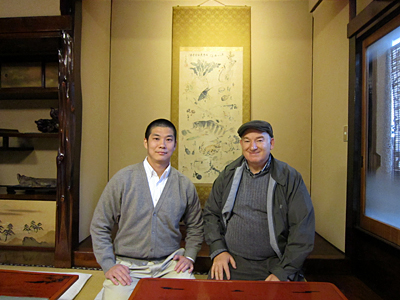 |
|
(文)太田美代
(英訳)デイビッド・A・セイン |
 1959年、米国生まれ。証券会社勤務を経て来日し、翻訳・通訳など多岐にわたって活躍。豊富な教授経験を生かし、数多くの英語関係書籍を執筆。近著に『日本人のチョットへんな英語』(アスコム)、『超入門シャドーイング』(主婦の友社)、日本人が使いすぎる英語(PHP文庫)など多数。
1959年、米国生まれ。証券会社勤務を経て来日し、翻訳・通訳など多岐にわたって活躍。豊富な教授経験を生かし、数多くの英語関係書籍を執筆。近著に『日本人のチョットへんな英語』(アスコム)、『超入門シャドーイング』(主婦の友社)、日本人が使いすぎる英語(PHP文庫)など多数。
















